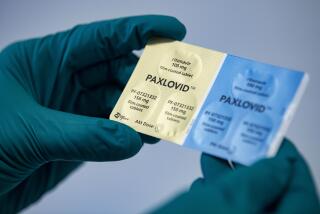Antibiotics Overprescribed, Study Finds
- Share via
As health experts warn of the growing danger of antibiotic resistance, a new study suggests that doctors are partly to blame: They encourage resistant bugs to flourish by treating many people who have colds and other viral respiratory ailments with antimicrobial drugs that are virtually useless.
In their survey of 29,000 patient visits to about 1,500 physicians nationwide, medical researchers based at the University of Colorado found that just over half the patients with a cold or an upper respiratory tract infection, and 61% with bronchitis, received an antibiotic prescription.
The great majority of such respiratory infections are caused by viruses, which the antibiotics do not kill, as opposed to bacteria, which are susceptible to the drugs.
Overall, the researchers found that doctors inappropriately issued at least 12 million antibiotic prescriptions for those ailments in 1992, amounting to 21% of all antibiotics prescribed. “We were surprised that one in five antibiotics were prescribed for conditions that they don’t even help,” said the study’s lead author, Dr. Ralph Gonzales. He said additional data collected last year suggests a pattern similar to that found in the study, which appears today in the Journal of the American Medical Assn.
Because the research draws on such a broad sampling of physicians and patients, researchers say that it offers the most complete picture yet of how routine medical care can contribute to what the Centers for Disease Control and Prevention calls the “emerging global problem of antimicrobial resistance.”
Increasingly, researchers warn, deadly infections that standard drugs once vanquished require greater vigilance and new weapons. Although 99% of the streptococcal bacteria that cause pneumonia were susceptible to penicillin in 1980, recent surveys of day care centers have found that up to 29% of pneumococcal infections among children had some resistance to the drug.
Doctors overprescribe antibiotics for many reasons, according to researchers. Patients with colds or other respiratory ailments expect and even demand such drugs. Physicians acquiesce because they feel too rushed to explain why an antibiotic might not be called for, according to focus group studies involving doctors. And doctors cannot always initially determine if a respiratory infection is bacterial or viral.
“Some patients have an expectation that an antibiotic will fix everything,” said Dr. Richard Kammerman, a family practice physician in Orange and past president of the Orange County Medical Assn. But usually, antibiotics do not fight illnesses caused by viruses, he said.
Often, a doctor will prescribe an antibiotic if a patient is not getting better after several days, because a viral infection can lead to a secondary bacterial infection against which the drugs can be effective, he said.
Talking to a patient, describing how a viral illness needs to run its course and explaining why antibiotics may actually do harm requires taking time and developing a rapport, said Dr. Melvyn Sterling, an internist in Orange. Today’s time constraints and large patient loads run counter to that kind of dialogue, he said.
“People will call their physician and say, ‘Can’t you give me something,’ and the something the patients expect is an antibiotic,” Sterling said. Their spouse or co-worker might have been given a prescription, and they expect to get one too, he said.
To reduce such overprescribing, the CDC and the American Academy of Family Physicians are developing physician training and public education programs. An editorial in the AMA journal urges doctors to “identify where they can decrease unnecessary antimicrobial use by improving diagnostic methods or communicating with patients concerning the lack of benefit, potential adverse effects, and development of resistance associated with such therapy.”
Essentially, antibiotic resistance is the price paid for the 20th century’s extravagant success against invading microbes. It occurs when a drug wipes out nearly all the microbes in an infection, leaving perhaps just one especially hardy germ to survive. As that resistant germ multiplies, it can exchange genetic material with other germs of the same type, transferring the ability to withstand the antibiotic to them and giving rise to new, resistant strains.
To be sure, antibiotic resistance can develop even when doctors prescribe the drugs appropriately, against bacterial infections such as pneumonia. But in that case, the risk of fostering resistance is far outweighed by the benefit.
In contrast, antimicrobials prescribed against virus infections such as colds have no benefit in otherwise healthy people. However, that sort of “defensive medicine” is justified in patients with underlying conditions, doctors say, including congestive heart failure, chronic lung disease or a weakened immune system.
The study by the Colorado researchers, who worked with a University of Utah physician, also found that doctors too often prescribe antimicrobial drugs for sinus and inner-ear infections. But it is harder to pin down how much of that treatment is excessive, because those infections can be caused by bacteria or viruses. Underscoring U.S. doctors’ aggressive approach, Gonzales said 80% to 90% of inner-ear infections in this country are treated with antimicrobial drugs, compared to 30% in Europe.
Gonzales said that ideally no one with just a cold or upper respiratory infection should receive an antibiotic, whereas antibiotics should be given to perhaps 5% of those with bronchitis, which sometimes progresses to bacterial pneumonia.
Although there is evidence that patient demand for antibiotics is behind much of the overprescribing trend, a University of Oklahoma study suggests that consumers are willing to forgo drugs, provided doctors spend more time with them describing their condition and explaining why they may not need drugs.
Times staff writer Marcida Dodson contributed to this report.






